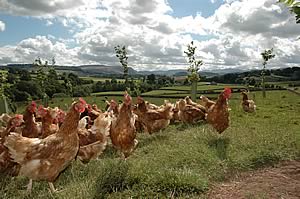 |
|||||||||
|
|||||||||||||||||||
Africa
should be top priority in battle to contain bird flu The deadly H5N1 bird flu virus remains a “potent threat around the world – both to animals and humans. The possibility of a human pandemic hangs over us,” the UN Food and Agriculture Organization warns in a statement prepared for delivery tomorrow at a major donor conference in Bamako, Mali.
“Failure by any one country to contain the disease could lead to rapid re-infection in many more countries,” says Mr Alexander Müller, FAO Assistant Director-General, warning: ”One weak link can lead to a domino effect, undoing all the good that we have achieved so far. Now is no time for complacency.” Several regions particularly vulnerable According to FAO, several parts of the world remain particularly vulnerable because of a shortfall in donor funding. They include: Africa, eastern Europe and the Caucasus as well as Indonesia. With the arrival of the virus this year in Africa there is much cause for concern. “Africa must now be a top priority for resources and technical assistance in the battle against avian influenza,” says the FAO statement. FAO also calls for continued commitment to “unaffected parts of the world like Latin America and the Caribbean, where FAO’s investment in national and regional preparedness planning is paying off.” Calls for increased surveillance and rapid response to disease outbreaks in poultry According to FAO, winning the battle against highly pathogenic avian influenza demands a long-term vision. Increased surveillance and rapid response to outbreaks are essential and these activities also provide positive knock-on effects for efforts to control other livestock diseases. FAO says that greater transparency and the sharing of information are critical, especially with regard to virus strains. “Scientific breakthroughs on improved diagnostics, vaccines and treatments can only emerge if virus information is shared widely and willingly, for the greater good.” In his statement, Mr Müller urges countries to place stronger emphasis on hygiene and movement control throughout the animal production and marketing chain to produce positive results. Strong support needed from donors and countries at risk FAO says that success in containing bird flu requires political commitment from both donors and the countries at risk or infected by the disease. “In Viet Nam, for example, an integrated strategy of surveillance and laboratory capacity building, movement control, vaccination and culling has averted what could have been a disaster for that country. It would not have been possible without the government’s resolute support and the backing of the international donor community.” Donors have strongly supported FAO’s work to help countries contain bird flu. So far, FAO has received US$76 million, and agreements have been signed for another US$25 million, with a further US$60 million in the pipeline.
|
|||||||||||||||||||

|
|
||||||||||||||||||
| home | agri-services | pedigree
pen | news | dairy | beef | machinery quota | property | organisations | site map |
|||||||||||||||||||

